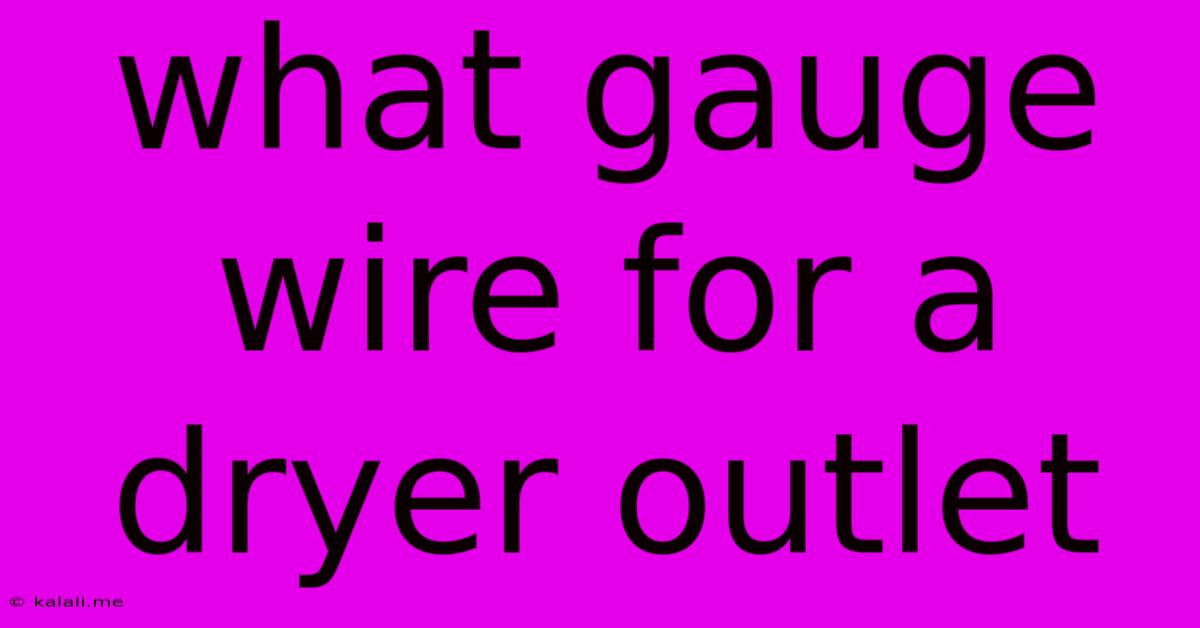What Gauge Wire For A Dryer Outlet
Kalali
Jun 01, 2025 · 3 min read

Table of Contents
What Gauge Wire for a Dryer Outlet? A Comprehensive Guide
Choosing the correct gauge wire for your dryer outlet is crucial for safety and efficient operation. Using the wrong gauge can lead to overheating, fire hazards, and even damage to your appliance. This guide will walk you through determining the appropriate wire gauge for your dryer, ensuring a safe and functional installation. This includes understanding amperage, voltage, and the National Electrical Code (NEC) requirements.
Understanding Amperage and Voltage:
Before selecting the wire gauge, you need to know the amperage and voltage requirements of your dryer. This information is usually found on the dryer's data plate, typically located on the back or inside the door. The data plate will specify the dryer's voltage (usually 240V in North America) and amperage (typically 30 amps or less, but some models might require higher). This information is paramount in determining the appropriate wire gauge.
The National Electrical Code (NEC) and Wire Gauge:
The NEC provides guidelines for safe electrical installations. It dictates the minimum wire gauge based on the amperage and the length of the run. Larger amperages require thicker wires (smaller gauge number) to handle the current safely. Longer runs also necessitate thicker wires due to voltage drop.
Here's a simplified breakdown based on common dryer requirements, referencing the NEC:
-
30-amp dryer: This is the most common amperage for dryers. The NEC typically recommends using 10-gauge wire for a 30-amp circuit. This ensures sufficient capacity to handle the dryer's power demands, minimizing the risk of overheating.
-
Higher Amperage Dryers: Some newer, high-capacity dryers may require a higher amperage circuit (e.g., 40 or 50 amps). In these cases, a smaller gauge wire (e.g., 8-gauge or 6-gauge) would be necessary. Always consult the dryer's installation manual and adhere to the NEC guidelines for the specific amperage.
Factors Affecting Wire Gauge Selection:
Beyond amperage, several factors influence the wire gauge selection:
-
Wire Length: Longer runs necessitate a thicker gauge wire to compensate for voltage drop. Excessive voltage drop can lead to reduced performance and potential damage to the dryer. Consult a qualified electrician if the run is unusually long.
-
Type of Wire: The type of wire, such as copper or aluminum, also plays a role. Copper is more commonly used for its superior conductivity. Aluminum wiring is less common in modern installations due to its susceptibility to oxidation and potential connection issues.
-
Installation Location: The environment where the wiring is installed (e.g., through walls, conduit) might influence the gauge choice to account for additional heat dissipation considerations.
Safety First:
Using the incorrect gauge wire is a serious safety hazard. An undersized wire can overheat, causing a fire. Always prioritize safety and consult a qualified electrician if you are unsure about the appropriate wire gauge or any aspect of electrical wiring.
Conclusion:
Choosing the right gauge wire for your dryer outlet is a critical aspect of electrical safety and appliance performance. By understanding the dryer's amperage requirements, referring to the NEC guidelines, and considering other relevant factors, you can ensure a safe and efficient installation. If you have any doubts, don't hesitate to consult a qualified electrician – their expertise is invaluable for safe electrical work. Remember, safety should always be your top priority when working with electricity.
Latest Posts
Latest Posts
-
How Long To Defrost Refrigerator Coils
Jun 02, 2025
-
Well Pump Runs But No Water
Jun 02, 2025
-
How To Replace This In A Sentence
Jun 02, 2025
-
Were John The Baptist And Jesus Cousins
Jun 02, 2025
-
Dealer Has 1 11 You Have 13
Jun 02, 2025
Related Post
Thank you for visiting our website which covers about What Gauge Wire For A Dryer Outlet . We hope the information provided has been useful to you. Feel free to contact us if you have any questions or need further assistance. See you next time and don't miss to bookmark.